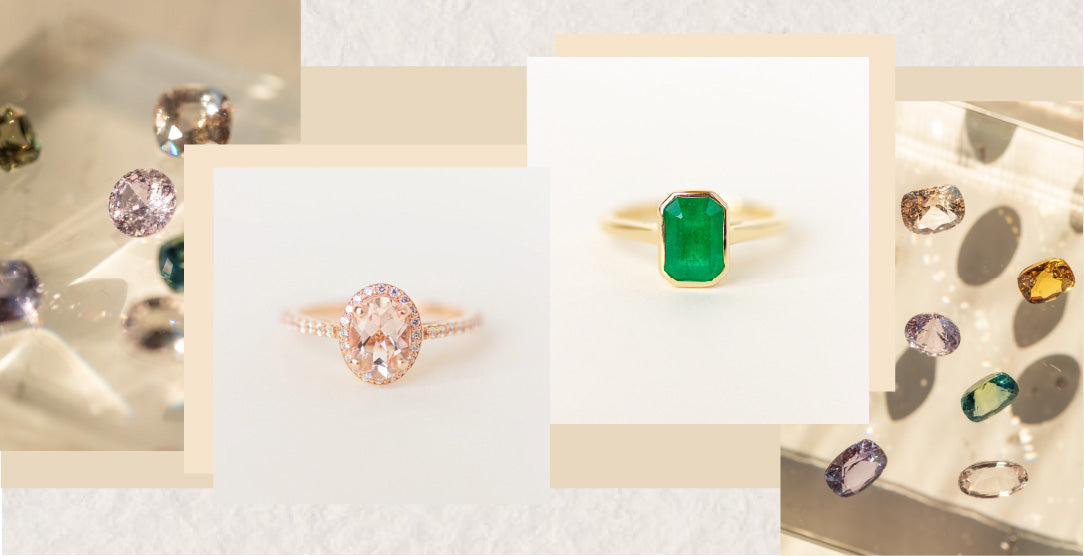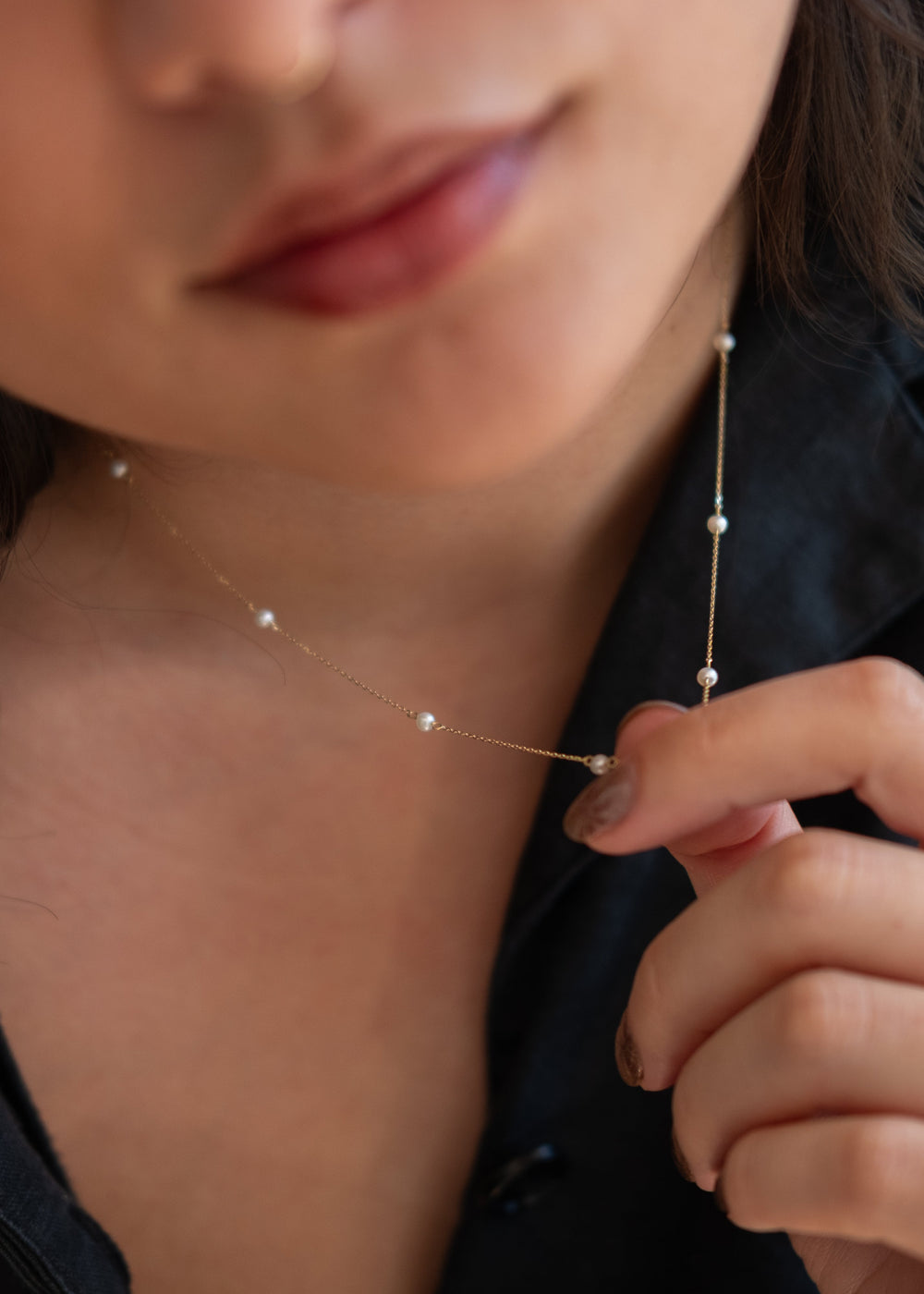
Non-Diamond engagement rings are having a huge moment, but that doesn't mean they aren't a long time classic (hello, Princess Diana's beauty of a sapphire!) We have put together a guide on a few of the most popular gemstones, ranging from diamond lookalikes to bright and colourful stones.
Moissanite

Pictured: Beatrice, Penelope & Adah
If you like the look of diamonds, but are wanting something with a smaller carbon footprint and price tag, moissanites are a wonderful option.
Moissanite was discovered in 1893 in a meteor crater, and is extremely rare and scarce to find in nature. However, the miracle of modern science means most moissanite on the market is lab grown—making it far more affordable than diamonds. We only offer the best of the best moissanite, which is the Forever One moissanite by Charles & Colvard. They are colourless and are graded DEF in the GIA colour grading scale.
Moissanite is rated at 9.25 on the Mohs Scale of Hardness, on which diamonds are rated 10 out of 10, making them tougher than just about every other mineral used in jewellery.
Moissanite’s Brilliance & Refractive Index is rated as 2.65-2.69, whereas diamonds are rated around 2.42. That means moissanite is actually more brilliant than diamond! A purchase of every Forever One moissanite comes with a certificate of authenticity and a Charles & Colvard limited lifetime warranty.
Sapphire

Pictured: Amelia, Audrey & Constance
Whether you are looking for a more subdued colourless stone, or something with a unique and bold colour, there is a sapphire out there for just about everyone.
Sapphires come in pretty much every colour of the rainbow, but the most common shades are blue, white, yellow, and pink. In more recent years, the teal colour, often referred to as Montana sapphire has been a very trendy colour. Within each colour, there are varying shades. Typically, the more intense the colour is, the better quality. In terms of deepness of the shade, medium to dark is the most desirable shade. There are also white sapphires, which are a clear stone that appear quite glassy, so if you are wanting something colourless but less glittery than a diamond, a white sapphire could be the stone for you.
Sapphire is a mineral called corundum, and has a Brilliance & Refractive Index of 1.76-1.77. They are rated as a 9 on the Mohs Scale of Hardness, which makes them quite a durable option, though they still need to be treated with care!
Emerald

Pictured: Yves & Custom Jolie
Emerald is a product of the mineral beryl, coloured by chromium or vanadium. Its trademark is its rich green colour.
There are many varying colours of emerald, and no two are ever alike. The green colour ranges from yellowish green to blueish green. The intensity of the colour varies from light green to dark green. Choice of colour and its intensity is personal preference, however, the bluish rich green colour is known to be the most desirable. There are also varying amounts of inclusions in emeralds, making each stone very unique from the next. Inclusions are materials that get trapped in the stone during its formation. Inclusions in other stones such as diamonds are considered a flaw, but in emeralds, they add charm and natural beauty. The more clear and less opaque the stone is, generally it is valued more. It is not recommended to steam clean or to put emeralds through an ultrasonic cleaner due to the inclusions - the best way to keep your emerald clean is to use some hot water with a tiny bit of soap, and a gentle scrub.
Emerald, or beryl, is rated as a 8 on the Mohs Scale of Hardness.
Aquamarine

Pictured: Eva & Islene | Center photo from Allie & Sam
Aquamarine is a product of the mineral beryl, and is a blue cyan colour. Aquamarine has a Brilliance & Refractive Index of 1.57-1.58.
Aquamarine comes in varying colours from very pale blue to clear sky blue to greenish blue. Typically richer the colour, more valuable the stone is.
Aquamarine is rated as a 8 on the Mohs Scale of Hardness.
Morganite

Pictured: Genevieve, Mathilde & Rosalie
Morganite, named for world famous financier JP Morgan and originally found in Madagascar, is a mineral called beryl. It comes in varying shades of pale pink, rose, peach and salmon. Generally speaking, the more saturated the colour is, the higher the stone is valued. Morganite has a Brilliance & Refractive Index of 1.58-1.59 and is rated as a 7.5-8 on the Mohs Scale of Hardness.
Opal

Pictured: Allerton (Vintage) & Aurora
Opal is the product of rain that has soaked deep into ancient underground rock, carrying dissolved silica. After the evaporation of the water, the solid deposits left over forms opal. Opal has a Brilliance & Refractive Index of 1.37-1.42.
Opal comes in many different colours from white to black to blue. They all have the same characteristic of having a sheen of rainbow colours due to a similar effect as light travelling through a prism. For engagement rings, semi-transparent white opal with a splash of rainbow has been the most popular choice.
Opal is rated as a 6 on the Mohs Scale of Hardness.
Moonstone

Pictured: Ondine & Custom Kate
Moonstone is composed of two feldspar species, orthoclase and albite. The two species intermingle and as they cool, the two species separate into stacked, alternating layers. When light falls between these thin, flat layers, it scatters in many directions, creating its unmistakable glimmer and lustre. Moonstone has a Brilliance & Refractive Index of 1.52-1.53.
Generally the more transparent and colourless the stone, and more blue the shine, the higher the quality. The cloudier and more opaque the stones are more abundant, and therefore less desirable.
Moonstone is rated as a 6 on the Mohs Scale of Hardness.
Caring for your Gemstones
To keep your stone looking as sparkly and clear as the day you got it, we recommend pouring hot water into a small dish, as well as the tiniest drop of dish soap and giving your ring a good swish around (we recommend using a chopstick!). Afterwards, give it a gentle scrub underneath the stones using something like a soft bristled toothbrush. You can also take your ring into your jeweller to have it professionally cleaned every 6 months to a year, but please note that Emeralds, Aquamarines, Morganites, Opals and Moonstones cannot be cleaned in an Ultrasonic cleaner.
Whether you are going to be opting for a diamond, or one of these alternatives, all of our ring designs can be made with just about any of these stones. If you don't see the option online, shoot us an email!
What type of stone are you thinking of for your dream ring?




Leave a comment